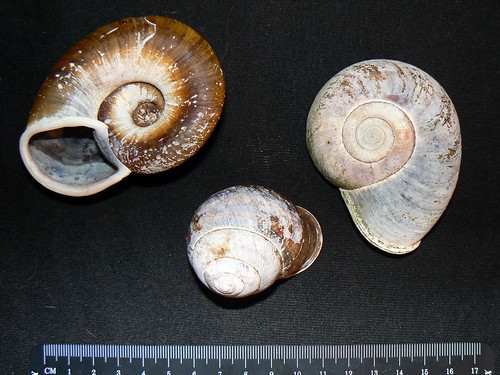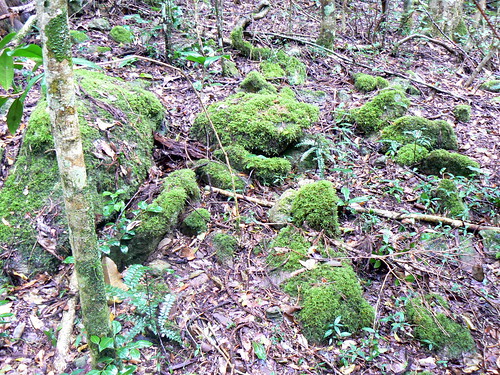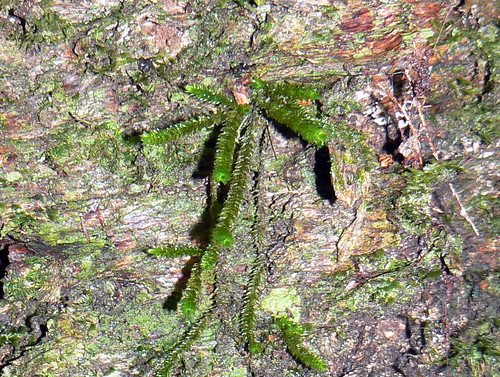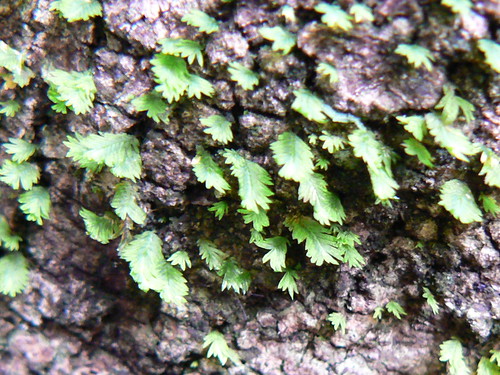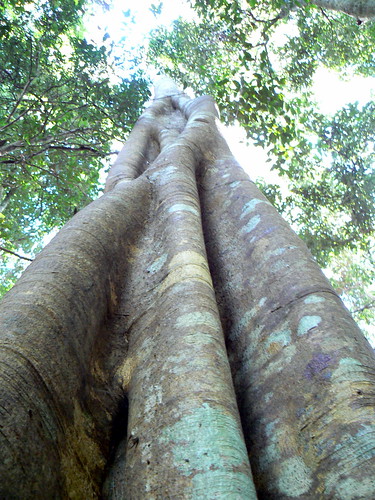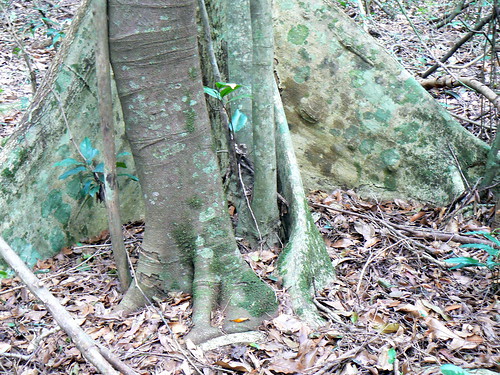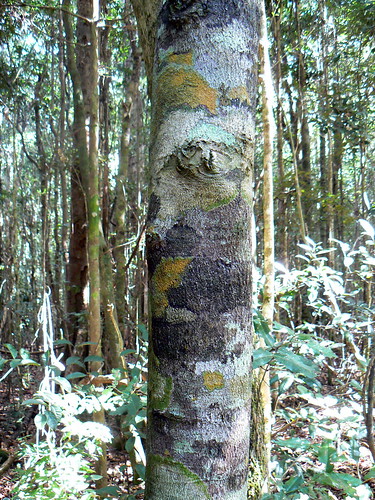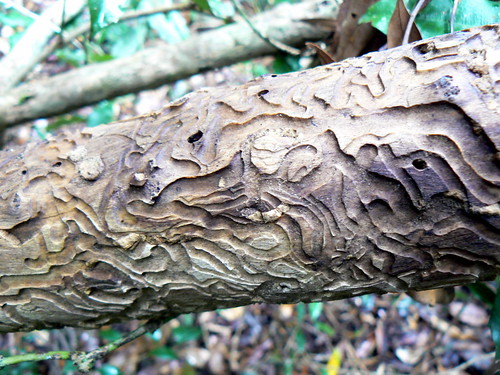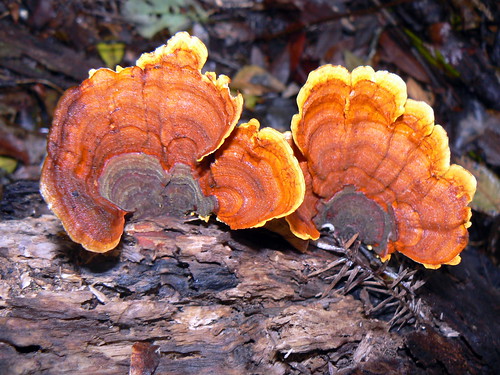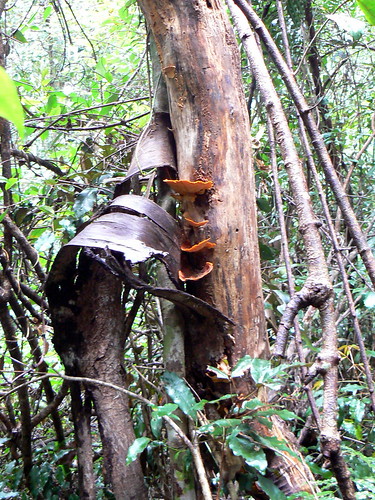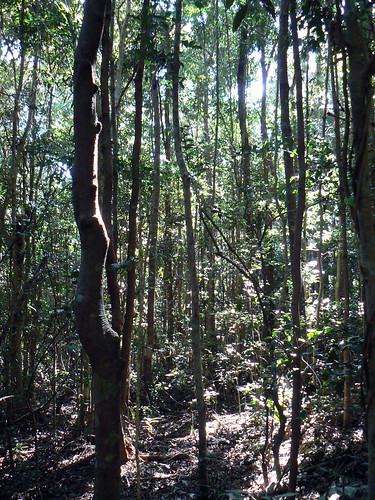I've just cleaned and photographed three snail shells that I found in the rainforest floor in Bulburin. Shortly I hope to have an identification of them, and will post the results here. In the meantime, gaze in wonder!
As you can see from the scale, these are mighty molluscs. The largest shell is 84 mm in length.
Saturday, August 28, 2010
Friday, August 27, 2010
Adventures in a subtropical rainforest: Part 5
In the final post of this series, some mosses of the subtropical rainforest. Mosses are plants that evolved well before the flowering plants (angiosperms), conifers and ferns. They have lack a vascular system, which means that they require constant moisture to avoid desiccation. Mosses reproduce by way of spores rather than seeds and have a fascinating life cycle in which haploid and diploid generations alternate.
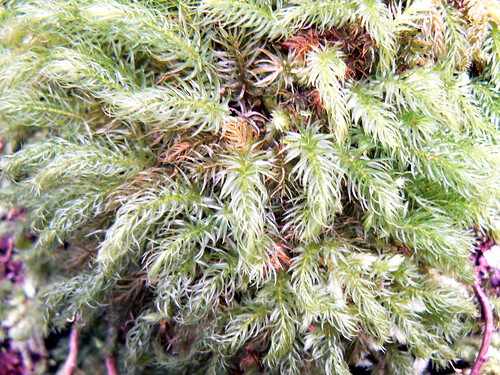

Before I sign off from this spate of posts, here's a mystery. These worms, which essentially resembled earthworms (phylum Annelida) were at around chest height. They appeared to be dead, but recently so. Any thoughts as to what they were doing there, and how they got there? I'm flummoxed!
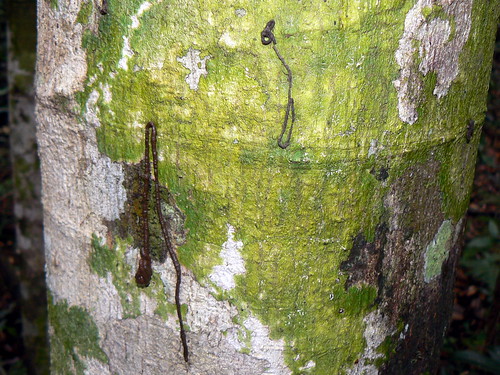 |
| Why am I here? |
Adventures in a subtropical rainforest: Part 4
The next of this series of posts on Bulburin National Park will look at some lichen I observed in the rainforest. Bryophytes and lichens have long fascinated me, possibly because once you look closely, they themselves can look like intricate forests of great complexity and beauty. The moisture level of rainforests allows them to flourish there.
This enormous Ficus sp. is covered with an array of lichens of various hues. Lichens are the result of a symbiosis between a fungus and an algae. The algae provides sugars produced by photosynthesis, and in return, the fungi supply the algae with nutrients it extracts from the substrate--in these cases, the bark of the tree.
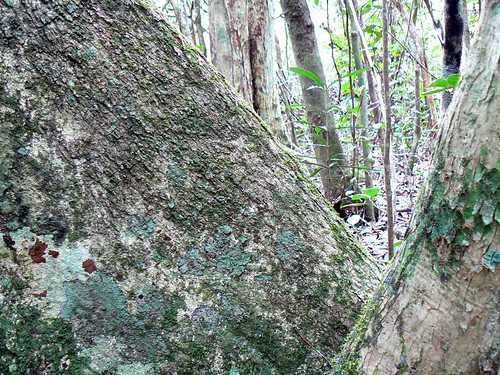
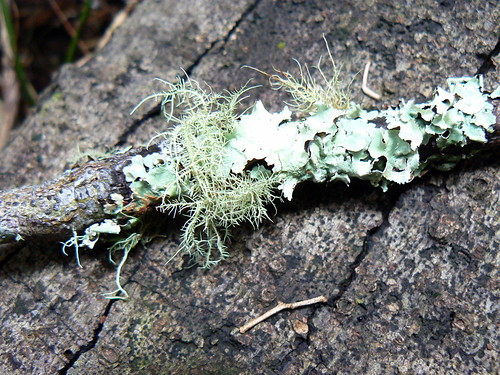
Next post: Mosses.
This enormous Ficus sp. is covered with an array of lichens of various hues. Lichens are the result of a symbiosis between a fungus and an algae. The algae provides sugars produced by photosynthesis, and in return, the fungi supply the algae with nutrients it extracts from the substrate--in these cases, the bark of the tree.


Next post: Mosses.
Adventures in a subtropical rainforest: Part 3
In this post, I'll concentrate on food. No, not the endless country pub meals of steak and chips, but the cuisine that consists of rainforest flora, both dead and alive. Of course, the substrate is alive with arthropods of huge diversity, but I wasn't digging down to find them. Insects made their appetite evident in the eaten leaves of many plants, but this is a particularly nice example of insect herbivory:
This is a beetle gallery, the result of bark beetles boring through the outer bark of the tree, then eating tunnels through the cambium layer beneath. Here the bark has been shed.
The great consumers of dead (and sometimes living) plant material are the fungi. What we see above ground or on the surface of logs are just the fruiting bodies. Beneath, there are kilometres of minutely thin filaments digesting and breaking down wood and other organic matter, converting it into a form that's usable by bacteria. Bulburin boasts some spectacular specimens.
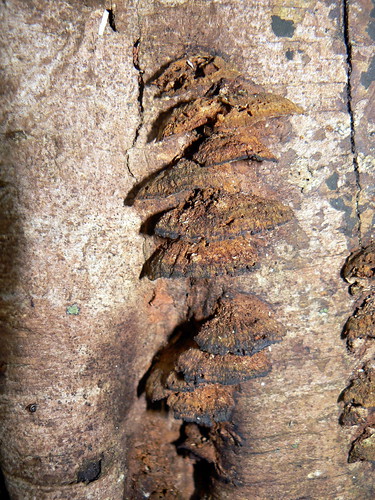
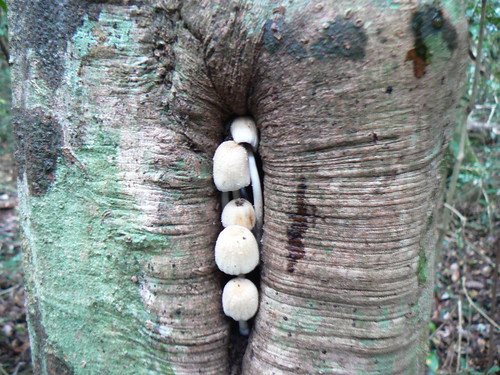
Next post: Lichen.
This is a beetle gallery, the result of bark beetles boring through the outer bark of the tree, then eating tunnels through the cambium layer beneath. Here the bark has been shed.
The great consumers of dead (and sometimes living) plant material are the fungi. What we see above ground or on the surface of logs are just the fruiting bodies. Beneath, there are kilometres of minutely thin filaments digesting and breaking down wood and other organic matter, converting it into a form that's usable by bacteria. Bulburin boasts some spectacular specimens.


Next post: Lichen.
Adventures in a subtropical rainforest: Part 2
For a politics junkie like me, finding yourself on Federal election night in a tiny Queensland outpost (pop.15, one pub, one single-cop police station and nothing else) can be somewhat of a shock. Normally I'm surrounded by like-minded Greens, browsers open on various election result sites, the TV being channel-hopped to find the juiciest snideries from the politicians commentating.
This time I was sitting with Chris Lusk in the bar of aforementioned pub (where we were staying), watching a hazy image on a small wall-mounted TV, and we were clearly the only people there even faintly interested in who the government was going to be. The jukebox was loudly accompanying the two pool players with Credence Clearwater Revival and Deep Purple, which made hearing Kerry O'Brien and Antony Green just a touch difficult.
But if the hamlet of Many Peaks feels isolated, delving into the nearby rainforest is akin to being on the dark side of the moon. Bulburin National Park is a subtropical notophyll rainforest, one of the largest remnants of rainforest in Queensland. The area around Many Peaks is schlerophyll forest, the transition to rainforest occurring as you climb the mountain.
Within metres of the road, it's easy to lose your bearings (particularly if your bearings happen to be as fragile as mine!) The forest is dense and moist, with creepers climbing up the trees and criss-crossing your path. Some are prickly, so if you lose your balance, you need to be cautious about what you grab.
The most overwhelming impression of rainforest is the rapid turnover of resources, the constant cycle of decay and regeneration. In the ferocious competition for light, plants reach up to the canopy, climbing upon each other. If a forest giant falls and allows the sunshine to stream in, hundreds of seeds will germinate in the patch exposed, fighting each other for nutrients and access to the sky above.
Everything is either food or a foothold, a place to live.
Next post: Fungi!
This time I was sitting with Chris Lusk in the bar of aforementioned pub (where we were staying), watching a hazy image on a small wall-mounted TV, and we were clearly the only people there even faintly interested in who the government was going to be. The jukebox was loudly accompanying the two pool players with Credence Clearwater Revival and Deep Purple, which made hearing Kerry O'Brien and Antony Green just a touch difficult.
As it became increasingly apparent that there would be a hung parliament, the following days were massively frustrating. No radio reception, no mobile reception, and of course, nothing even faintly resembling an Internet. To get a newspaper, we had to drive a good half hour to the nearest town--and the newspapers were out-of-date.
 |
| The road through Many Peaks, with the flood-way of Deception Creek. |
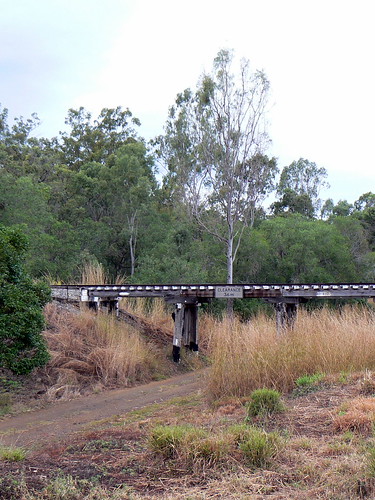 |
| Many Peaks Railway Bridge. |
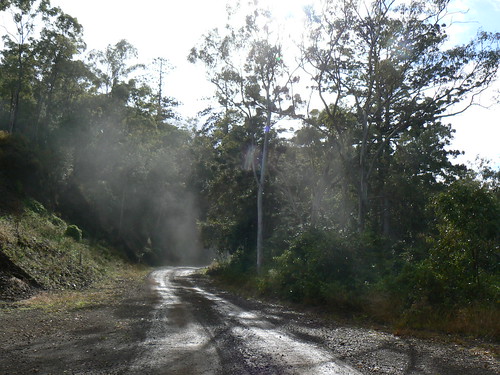 |
| The road to the rainforest. |
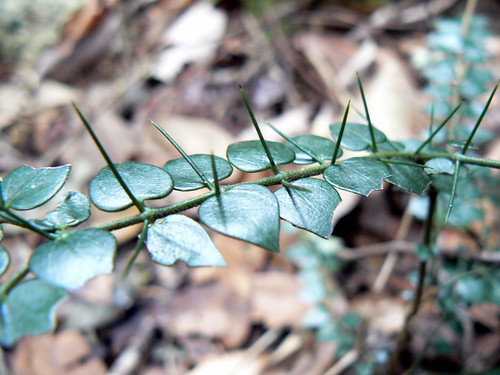 |
| Ouch. |
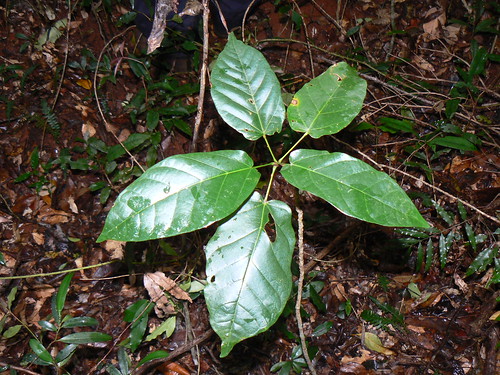 |
Extra ouch: Dendrocnide photinophylla, Giant Stinger. |
The most overwhelming impression of rainforest is the rapid turnover of resources, the constant cycle of decay and regeneration. In the ferocious competition for light, plants reach up to the canopy, climbing upon each other. If a forest giant falls and allows the sunshine to stream in, hundreds of seeds will germinate in the patch exposed, fighting each other for nutrients and access to the sky above.
Everything is either food or a foothold, a place to live.
 |
| A vine embraces a rainforest tree. |
 |
| Reaching the light. |
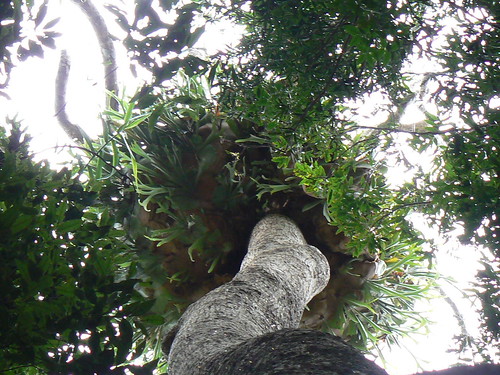 |
| An elkhorn fern (Platycerium sp.) colony atop a dead rainforest tree. |
Next post: Fungi!
Adventures in a subtropical rainforest: Part 1
Yesterday I flew home from a six day field trip to Bulburin National Park, in Queensland. It's just a touch south of the Tropic of Capricorn.
View Bulburin National Park, Queensland in a larger map
I was there as part of my role as research assistant to Chris Lusk, of Macquarie University's Department of Biology. Chris runs the Forest Ecology lab. He's researching the relationship between shade tolerance, light and growth in a range of rainforest tree species across tropical, sub-tropical and temperate rainforests in Australia and New Zealand. Later this year, we'll be visiting a temperate rainforest in South-West Tasmania.
Among the measurements we made at Bulburin was the light reaching individual saplings through the canopy. This is done by hemispherical photography, which uses a fish-eye lens and records the light obstruction by surrounding trees and shrubs. Here's an example that Chris took on a previous field trip:
When I get back to the lab, one of my jobs will be to work out the precise amount of light that reaches each of the hundreds of specimens we tagged and measured.
Over the next few posts, I'll be putting up some photos of the rainforest and surrounds. The camera very much enjoyed its workout in the bush!
Next post: The fight for light.
View Bulburin National Park, Queensland in a larger map
I was there as part of my role as research assistant to Chris Lusk, of Macquarie University's Department of Biology. Chris runs the Forest Ecology lab. He's researching the relationship between shade tolerance, light and growth in a range of rainforest tree species across tropical, sub-tropical and temperate rainforests in Australia and New Zealand. Later this year, we'll be visiting a temperate rainforest in South-West Tasmania.
Among the measurements we made at Bulburin was the light reaching individual saplings through the canopy. This is done by hemispherical photography, which uses a fish-eye lens and records the light obstruction by surrounding trees and shrubs. Here's an example that Chris took on a previous field trip:
When I get back to the lab, one of my jobs will be to work out the precise amount of light that reaches each of the hundreds of specimens we tagged and measured.
Over the next few posts, I'll be putting up some photos of the rainforest and surrounds. The camera very much enjoyed its workout in the bush!
Next post: The fight for light.
Subscribe to:
Posts (Atom)
